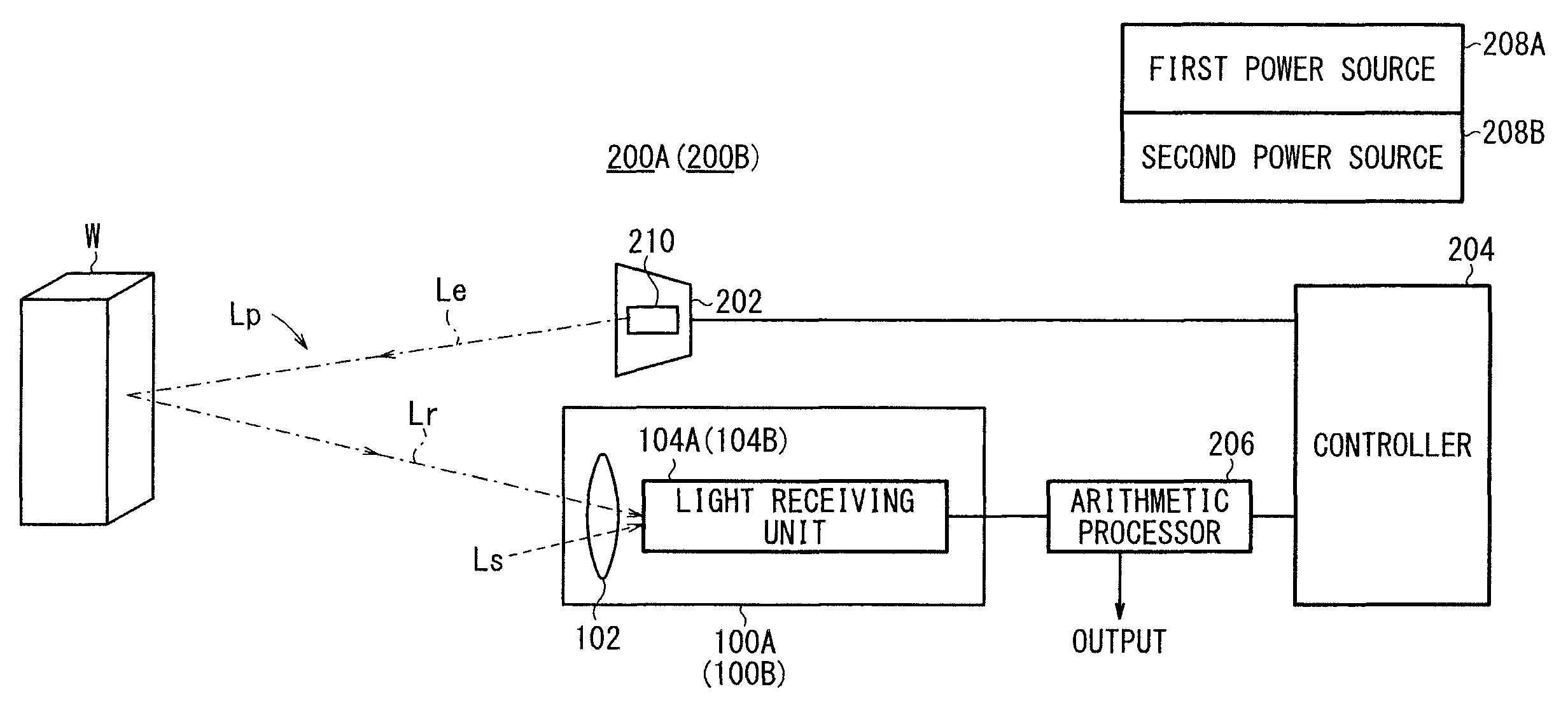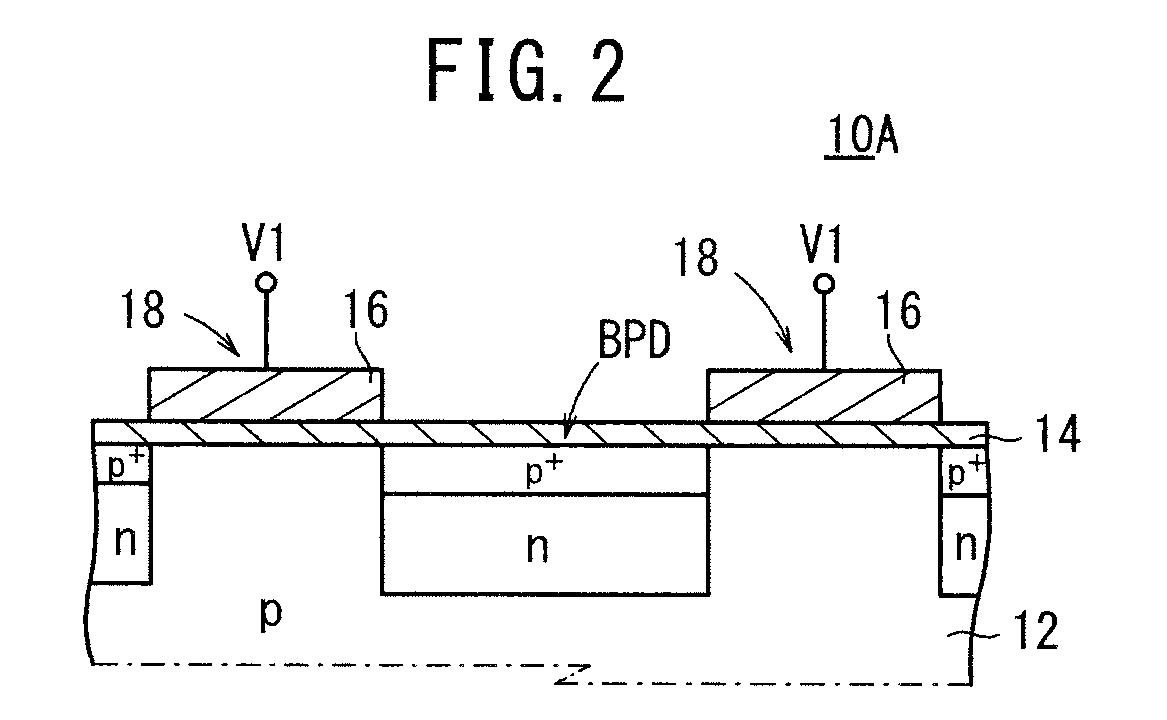Photoelectric conversion element, light receiving device, light receiving system, and distance measuring device
a technology of photoelectric conversion and light receiving, which is applied in the direction of distance measurement, instruments, and using reradiation, etc., can solve the problems of time required for transferring to the output side all of the photoelectrons, the difference in the transfer efficiency between the two nodes, and the difficulty of photoelectrically converted photoelectrons to be transferred at high speeds. achieve the effect of improving the s/n ratio, reducing the influence of ambient light noise components, and high accuracy
- Summary
- Abstract
- Description
- Claims
- Application Information
AI Technical Summary
Benefits of technology
Problems solved by technology
Method used
Image
Examples
first embodiment
[0096]First, as shown in FIGS. 1 and 2, a photoelectric conversion element (hereinafter referred to as a first photoelectric conversion element 10A) according to the present invention includes one MOS diode 18 having an electrode 16 formed on a semiconductor substrate (see FIG. 2) with an insulator 14 disposed therebetween, and embedded photodiodes BPD formed on the semiconductor substrate 12. More specifically, as shown in FIG. 2, for example, the semiconductor substrate 12 is formed by a p-type impurity diffusion region. Additionally, the aforementioned MOS diode 18 is made by forming the electrode 16 from polysilicon or a metallic conductor or the like on the semiconductor substrate 12 via an insulator layer (insulator 14) made from SiO2 or the like. Further, the aforementioned embedded photodiodes BPD are constituted respectively by forming a high density p-type impurity diffusion region on the surface of an n-type impurity diffusion region, which itself is formed on a p-type im...
second embodiment
[0107]Next, a photoelectric conversion element (hereinafter referred to as a second photoelectric conversion element 10B) according to the present invention shall be described with reference to FIGS. 6 through 9.
[0108]As shown in FIG. 6, the second photoelectric conversion element 10B includes roughly the same structure as the aforementioned first photoelectric conversion element 10A, however, the second photoelectric conversion element 10B includes one first MOS diode 18a having a first electrode 16a, which is formed on the semiconductor substrate (see FIG. 7) with an insulator 14 disposed therebetween, and plural second MOS diodes 18b having second electrodes 16b, which are formed on the semiconductor substrate 12 with the insulator 14 disposed therebetween. The first MOS diode 18a is constituted the same as the MOS diode 18 of the aforementioned first photoelectric conversion element 10A. More specifically, for example as shown in FIG. 7, the semiconductor substrate 12 is formed ...
third embodiment
[0294]As shown in FIG. 29, a photoelectric conversion element (hereinafter referred to as a third photoelectric conversion element 10C) has substantially the same structure as the aforementioned second photoelectric conversion element 10B, except that the shapes of the first electrode 16a and the second electrodes 16b are different, in particular, as viewed from the upper surface thereof.
[0295]More specifically, each of the branch portions 22 of the first electrode 16a has a shape such that the electrode width thereof gradually widens toward the one electrode portion 20 as viewed from the upper surface, and each of the second electrodes has a shape such that the electrode width thereof gradually narrows toward the one electrode portion 20 as viewed from the upper surface.
[0296]In the case that a potential location 32a beneath the one electrode 16a is focused on and viewed, as shown in FIGS. 30A and 30B, the portion thereof where the electrode width is narrow receives an influence f...
PUM
 Login to View More
Login to View More Abstract
Description
Claims
Application Information
 Login to View More
Login to View More - R&D
- Intellectual Property
- Life Sciences
- Materials
- Tech Scout
- Unparalleled Data Quality
- Higher Quality Content
- 60% Fewer Hallucinations
Browse by: Latest US Patents, China's latest patents, Technical Efficacy Thesaurus, Application Domain, Technology Topic, Popular Technical Reports.
© 2025 PatSnap. All rights reserved.Legal|Privacy policy|Modern Slavery Act Transparency Statement|Sitemap|About US| Contact US: help@patsnap.com



